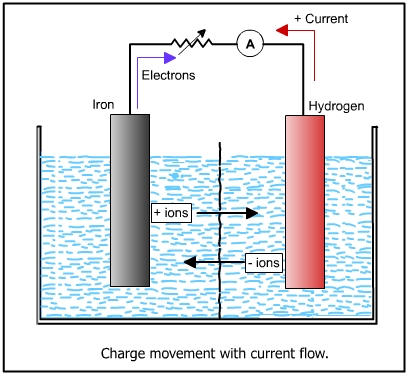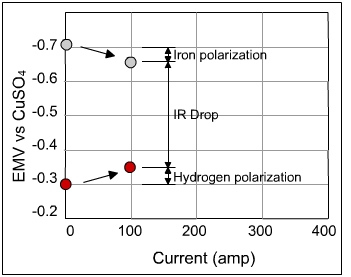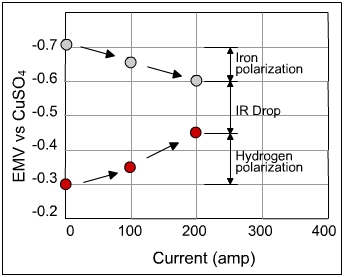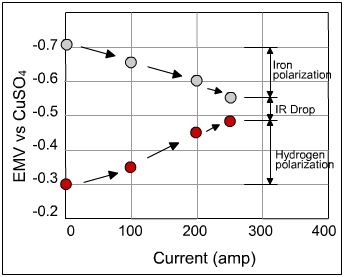
| 2. Understanding Corrosion | |
|
2.6 A Look at Polarization [2/3] |
Illustration of Polarization:
Examine the following figure. Iron electrode forms the anode and a hydrogen electrode the cathode. A resistor is shown in the diagram.
Under equilibrium condition,
|
Current = 0 mA EFe = -0.7 V EH = -0.3 V Battery emf = 0.4 V IR Drop = 0 |

|
Now decrease the resistance. Current should start flowing. The positive Fe2+ ions would flow from anode to cathode (Hydrogen) and the negative anions from cathode to anode (Iron). Electrons would flow in the outer circuit from anode (Iron) to cathode (Hydrogen). The system is no more at equilibrium now. Polarization data at 100 mA shows that the potential of Fe is now displaced to -0.65 V and that of Hydrogen to -0.35 V as the battery emf at 100 mA is now reduced from 0.4 to 0.3 V as shown below.
|
Current = 10 0 mA EFe = -0.65 V EH = -0.35 V Battery emf = 0.3 V IR Drop = 0.3 V |

|
Polarization data on increasing the current from 100 mA to 200 mA (see figure below) shows a decrease in potential of Fe from -0.65 V to -0.6 V and that of H2 from -0.35 V to -0.45 V. Thus at higher current, the anode polarizes towards the cathode (more negative values) as hydrogen polarizes towards less active values.
|
Current = 20 0 mA EFe = -0.60 V EH = -0.45 V Battery emf =0.15 V IR Drop = 0.15 V |

|
Finally at 250 mA, the potential of iron shifts from -0.6V to -0.55V and that of hydrogen from -0.45 V to -0.48V. The polarization curve of both anode and cathode can be observed in the following figure.
|
Current = 250 mA EFe = -0.55 V EH = -0.48 V Battery emf =0.07 V IR Drop = 0.07 V |

|
The potentials of anode and cathode drift towards each other, bringing the emf virtually to zero. Thus polarization has been achieved as the electrodes are now polarized. The curves do not touch each other, because of the IR drop (explained under resistance polarization). The curves approach to a point where a driving force necessary to overcome the circuit resistance is provided. In sea water which is highly conductive, both curves would meet at a common point.